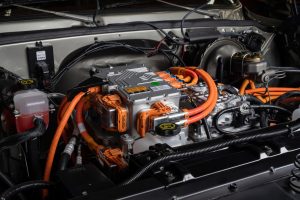
Where do you put the battery?
EV Conversions are becoming relatively common. Beyond DIY conversions, there is a growth of third-party shops that willing to transform ICE vehicles into full-scale electric transportation. Many small aftermarket companies currently offer basic modification parts and kits. Even major automakers are selling components that can be used to build your own EV.
Which leads to a pressing question. When you build an electric vehicle based on a gasoline car or truck, where do you place the batteries?

It is trivial to create an electric motor that will bolt in place of an existing ICE. Exhaust and fuel systems can be discarded. Some EV designs retain a coolant system for the batteries, but often this can be deep-sixed as well.
Batteries are crucial
But batteries are absolutely essential for an electric car or truck. And an EV battery pack needs to be many times the size of a typical fuel tank. You cannot replace an existing fuel tank with a similar size battery pack and achieve decent range. At least not with today’s technology.
This was abundantly clear when I saw the all-electric K5 Blazer-E created to showcase the new Chevrolet Electric Connect and Cruise package. Conceived as a concept vehicle for the recent SEMA360 show, the Blazer-E looks unchanged from its original 1977 configuration. The difference is the 200hp Bolt EV motor which Chevy dropped in to replace the original 175hp gasoline V-8.
The engineers took pains to maintain the original appearance of the Blazer-E. There is very little to betray the truck’s new electrified status. Even the original instrument cluster was rewired to display information about the electric motor.
Factory Blazer EV Conversion
The Blazer-E varies from a production Blazer in only one area, but it is a big one. A fairly large 60-kWh battery pack occupies almost all of the cargo area floor.
I have to admit I am a huge fan of the K5 Blazer. I have owned three of them and have put a considerable number of miles on each, both on and off-road. But I am not so sure about the Blazer-E. Since that battery takes up most of the cargo area, the conversion has taken a versatile five-passenger off-road machine and turned it into an oversized two-person runabout.
I have hauled tons of stuff in the back of my Blazers: building materials, camping gear, dogs, boat supplies, furniture, photography paraphernalia, road trip provisions and who knows what else. I spent many nights in the back of a Blazer. And I have carried people — lots of people — on trips long and short.
As it stands, none of this would be possible with the Blazer-E. If you built a subfloor over the battery, you could regain some of the cargo space, but the available capacity would be limited. Even worse, it doesn’t seem practical to include a rear seat. If you maintain the original rear seat height, there would be no legroom. Raise the seat sufficiently to provide legroom and there would be no headroom.
The trick would be to find a battery location that does not intrude into the cargo area. The Bolt motor takes up most of the free space in the engine compartment, so that is out. It might be possible to fit batteries into the narrow space between the inside bed walls and the outer sheet metal. But I am unsure how many battery packs could be installed in his location, and the extra weight might affect balance.
Finding an ideal EV conversion battery location
The ideal battery location would be underneath the stock Blazer cargo floor. This leaves the cargo area free for seating or transporting items.
I haven’t investigated the practicality of installing a battery in this location. Since Chevy Performance didn’t attempt this, it would probably entail a lot of work. There has to be adequate clearance for the rear differential, driveshaft and rear springs to move up and down. And since this is an offroad vehicle, the battery would require its own skid plate to protect it from rock damage.

All this demonstrates how difficult finding a home for a battery pack can be. A K5 Blazer is considerably larger than a Chevy Bolt, but the Bolt’s power cells are stored unobtrusively out of the way. Since the Bolt was designed from the ground up as an electric car, the engineers had the freedom to put the batteries wherever they wanted. Vehicles like the converted Blazer-E require extensive thought and planning and sometimes sacrifices need to be made.
Blazer-E: blazing a trail
Which doesn’t negate the worthiness of the Blazer-E and other conversions. People will continue configuring DIY EVs. And the conversions will get better and more practical.
Meanwhile, battery packs are getting lighter, smaller and more efficient. As technology improves, turning a gas burner into an EV will become much simpler.
Until then, however, battery placement remains the most daunting obstacle to building your own electric vehicle.
The GM Media Press Release can be found here.

Be First to Comment